The Size of Alabama
If you pull out a map of the United States of America, you can find Alabama in the bottom right corner. It has a roughly rectangular shape, with a longer border north-south than east-west, and covers an area of 52,419 square miles. This makes Alabama the 30th-largest state in the U.S. Much of Alabama’s landscape is hilly and rural, and the state is full of river deltas, deep valleys, plains and prairies, and tall mountains in the northern part of the state. Though the size of Alabama may not be remarkable, there are so many other distinct qualities that make it something special.
This state in the deep south, which also goes by the nickname “the Heart of Dixie,” is not the biggest state in the U.S. It’s not the longest. It’s not the widest. Yet despite Alabama’s size, with a maximum distance of 329 miles from north to south, Alabama nevertheless has a diverse geography and unique traditions sure to entertain and enthrall any visitor. Though Alaska is the state with the longest distance from north to south (1,420 miles!), this other “A” state nevertheless covers plenty of terrain in its 329-mile length. Let’s learn all about Alabama’s size, history, geography, animals, and famous people now!
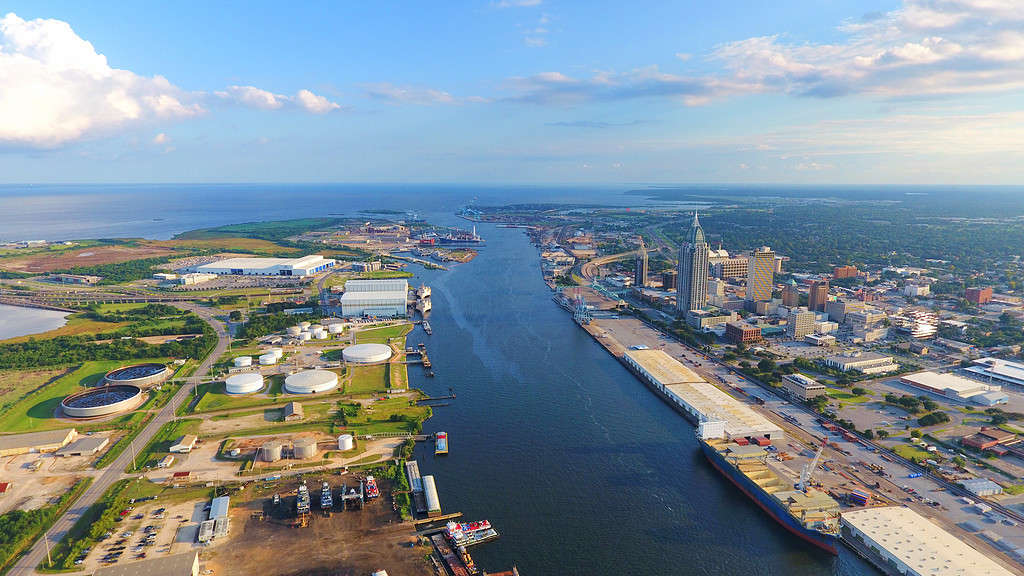
For a state of Alabama’s size, it really has it all: sandy beaches, winding rivers, mountain ridges, big cities, rural towns, and rolling farmland.
©George Dodd/iStock via Getty Images
Becoming Part of the United States
History
The land now called “Alabama” has a rich history dating back hundreds of years. Back then, the Paleoindian people group lived in parts of southeast North America. Before European settlers arrived, the major Native tribes living in the area now known as Alabama included the Choctaws, Creeks, Cherokees, Chickasaws, Alabama-Coushattas, and Yuchi. According to Choctaw scholar Allen Wright, the name “Alabama” actually comes from a word used by the Choctaw people: “Alba.” These people lived in and migrated through the area long before European settlers arrived.
European Settling of Alabama
When the era of European exploration of North America began, fights over the area now known as Alabama began. During the 1500s, Spanish explorers arrived in the area near modern-day Selma. Then, during the 1700s, French settlers arrived in south Alabama.
In 1763, the Treaty of Paris gifted to Great Britain the part of Alabama inhabited by European settlers. This area, which is now modern-day Mobile, Alabama, became part of the British territories. However, by 1780, Spain captured the area in the Revolutionary War. In 1783, the Treaty of Paris that ended the American Revolutionary War allowed Spain to have Mobile and gave the rest of the territory to the U.S.
Alabama officially joined the United States with a congressional resolution signed by President James Monroe. The resolution formally accepted the new Alabama constitution, allowing it to become part of the United States as the 22nd state. Congress passed this resolution on December 14, 1819, making Alabama a new state just over a year after Illinois became the 21st and several months before Maine became the 23rd.
During the 1800s, Alabama became a location of important agricultural production, particularly the planting and harvesting of cotton. During the American Civil War, the state was an important provider of food, military supplies, and other goods to the Confederate Army. Even today, parts of Alabama still produce cotton, as well as peanuts, corn, soy, wheat, and other agricultural crops.

Before it was the city it is today, Mobile, Alabama was one of the first settlement locations for Europeans in the area.
©George Dodd III/Shutterstock.com
The Five State Capitals of Alabama
The first seat of government in Alabama was St. Stephens, which served as the territory’s capital from 1817 to 1819. This old settlement overlooked the Timbigbee River. However, at the time that Alabama joined the United States, the state chose the city as Huntsville to become its first capital city. However, in 1820, the capital was moved to Cahaba (also spelled as Cahawba) until 1825. Cahaba served as the first permanent state capital. However, in 1825 the capital was moved again to Tuscaloosa. However, as the area claimed by Alabama expanded, the state legislature eventually chose Montgomery to become the state’s new capital city in 1846. Montgomery has been the state capital of Alabama ever since!
Today, Montgomery is a medium-sized city home to about 200,000 people. A culturally and historically significant city, Montgomery is home to the Alabama State Capitol building, the Montgomery Museum of Fine Arts, the Montgomery Zoo and Mann Wildlife Learning Museum, and many other attractions. It is also the site of a black granite Civil Rights Memorial to commemorate the 20th-century Civil Rights Movement. With the nickname “Capital of Dreams,” Mongtomery calls itself “a city rich in history, yet clearly focused on the future.”
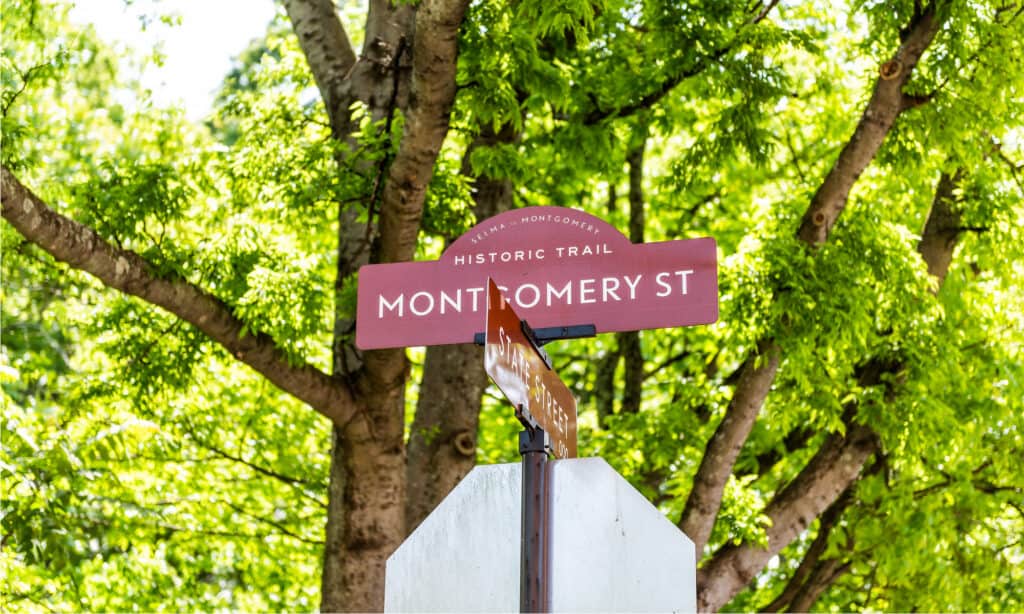
The route from Selma to Alabama’s capital city of Montgomery is a National Historic Trail commemorating the path to achieving Civil Rights.
©Kristi Blokhin/Shutterstock.com
Geography and Climate of Alabama
Alabama’s geography is varied and diverse, ranging from tall mountain ridges and deep valleys in the Appalachian foothills to incredible Gulf of Mexico coastlines, sandy beaches, and barrier islands on the southern shore. Alabama has a humid subtropical climate, with hot summers softened by cooling winds from the Gulf of Mexico. Alabama is bordered by Tennessee on the north, Georgia on the east, Mississippi to the west, and Florida and the Gulf of Mexico to the south. About 50,750 square miles of the state is land, while about 1,673 square miles is water.
Alabama may be divided up into five major land areas: East Gulf Coastal Plain, the Piedmont Upland, the Appalachian Ridge and Valley, the Cumberland Plateau, and the Highland Rim.
East Gulf Coastal Plain
The East Gulf Coastal Plain covers two-thirds of Alabama, starting at the south where the land meets the Gulf of Mexico, and reaching almost to the Tennessee border in the west. This part of the state has swampland, pine forests, farmland, hills, and more. The area called the Black Belt Prairie divides the East Gulf Coastal Plain into two halves: the southern half and the northern half. In this area, the ground is dark or almost black-colored fertile soil, relatively absent of trees. As a result, this band of rolling hills and farmland is where many of the largest Alabama plantations were built. Even today, visiting this area will likely bring you to fields full of corn, cotton, soybeans, and other agricultural land.
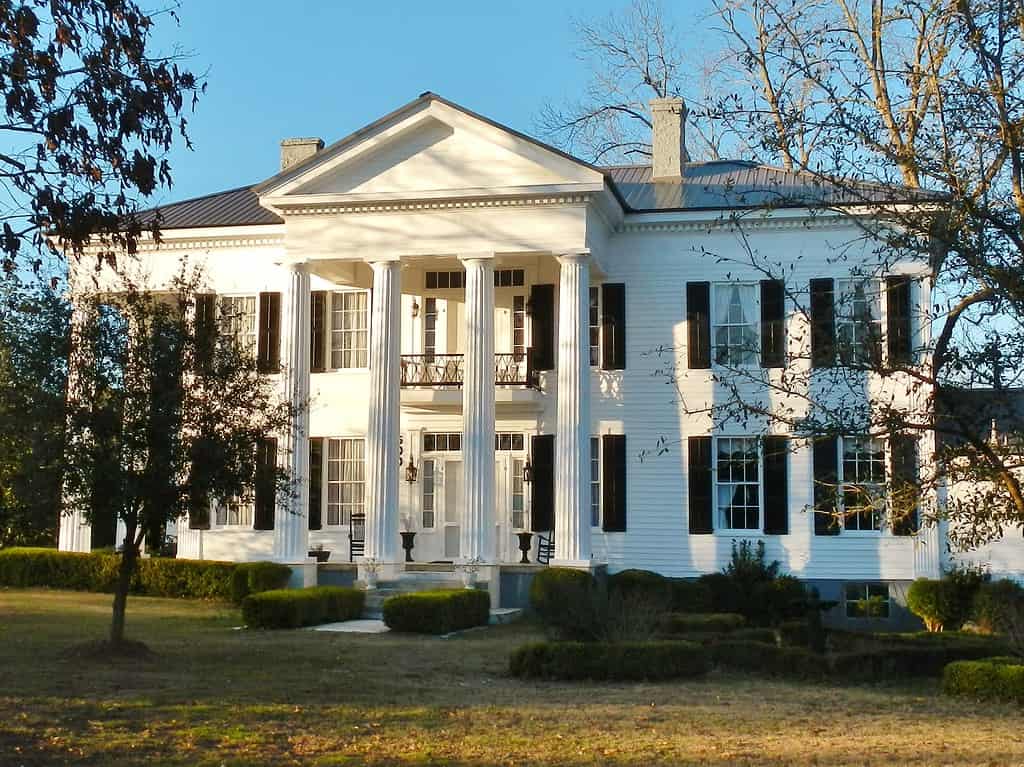
The Pillars plantation in Lowndes County, Alabama, was a historic cotton plantation. It was founded by a Scottish immigrant, John McMillan, in 1817.
©Rivers Langley / CC BY-SA 3.0 – License
Piedmont Upland
The Piedmont Upland region of Alabama consists of hills, ridges, sandy valleys, and terrain full of iron ore, coal, limestone, marble, and more. This region is a triangular section in the eastern and central parts of Alabama. This area is known for having Cheaha Mountain, the tallest point in Alabama, which reaches an elevation of 2,407 feet. Surrounding Cheaha Mountain, the region’s landscape is defined by hills and surface rock areas.

Cheaha Mountain is the tallest point in Alabama and offers beautiful outlook points from which hikers can take in the beautiful Alabama scenery.
©iStock.com/JimVallee
Appalachian Ridge and Valley
The Appalachian Ridge and Valley region of Alabama is just north of the Piedmont Upland area. This section of the state has sandstone ridges, valleys, and plenty of coal, iron ore, and limestone. Alabama has the southernmost part of the Appalachian Ridges, which stretch all the way north to New York. This area is characterized by long ridgelines cutting through the terrain, with long, thin valleys between the ridges.
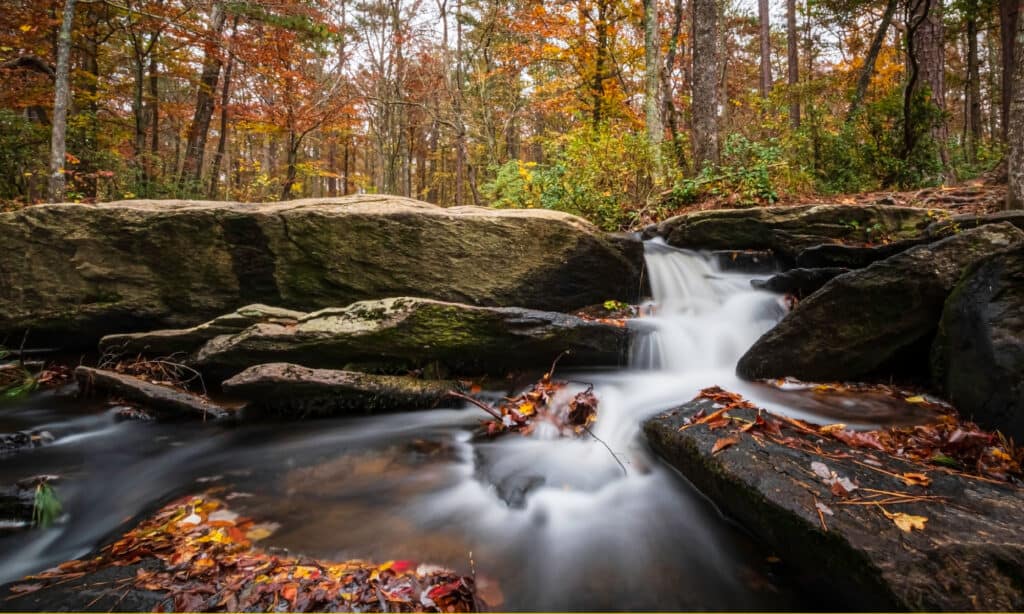
Cheaha Falls is around 30 feet tall and runs down Mt. Cheaha, Alabama’s highest peak, which are both part of the broader Appalachian area.
©iStock.com/Jacqueline Nix
Cumberland Plateau
The Cumberland Plateau is northwest of the Appalachian Ridge and Valley region. This area has rolling hills, sandstone plateaus, dolomite canyons, and ridges of limestone. This is one of the most scenic parts of Alabama, where many visitors come to enjoy outdoor recreation and beautiful nature.

Dismals Canyon is a sandstone gorge in Franklin County, Alabama, in the northwestern part of the state. Dismals Canyon was declared a National Natural Landmark in 1974.
©LindaPerez/Shutterstock.com
Highland Rim
Lastly, the Highland Rim region of Alabama sits in the northwestern corner of the state. The Highland Rim area is the southernmost part of the Appalachian Mountains’ low plateaus. Much of this land is part of the Tennessee River Valley region, where farmers grow crops such as corn and cotton. The Highland Rim is the smallest of all of Alabama’s regions, only encompassing about 7% of the entire state. This region is known for having a few low hills, ridges, valleys, and plenty of waterways and streams, including some occasional waterfalls that cascade down the side of mountain ridges.
Alabama’s Climate
Alabama gets approximately 56 inches of rain each year. This rain falls evenly across the state. As a result, Alabama rarely experiences drought, though the areas closer to the coastline do tend to get the most rain on average. However, Alabama’s location on the Gulf of Mexico does leave much of the state vulnerable to hurricanes and tropical storms, bringing high winds and torrential rain every year. Locals know that storms come starting in late summer and lasting into early fall. While the southern part of Alabama is most impacted by hurricanes, the northern part of the state is vulnerable to tornadoes.
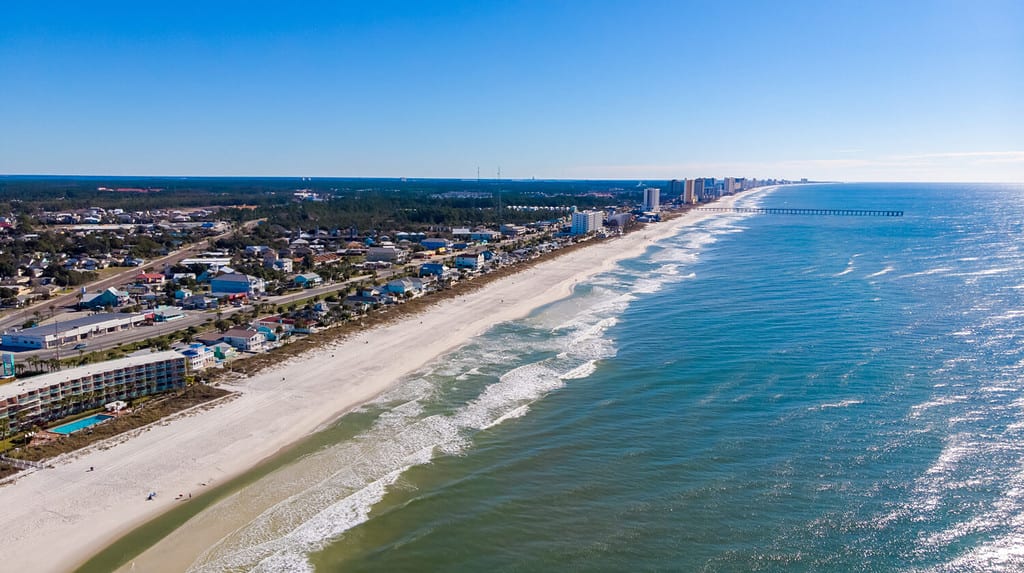
Gulf Shores, Alabama offers white sand and turquoise waters, but can also be susceptible to tropical storms and hurricanes.
©Pugalenthi Iniabarathi/Shutterstock.com
Overall Size of Alabama
Alabama is not the biggest or the smallest state. In fact, Alabama’s size makes it fit quite squarely in the middle of the rankings, as the 30th-largest state in the country. This might cause you to wonder just how big is Alabama? In fact, Alabama’s total land area adds up to 52,420 square miles. The state covers 33.55 million acres. Despite not being among the biggest states in the U.S., Alabama is still more than 30 times larger than the smallest state in the country! That’s right, Alabama is 30 times bigger than the New England state of Rhode Island. Rhode Island is the smallest state in the country and covers a total land area of only 1,545 square miles. However, Alabama still cannot compare to the immense size of the largest state in the country: Alaska. Alaska is 13 times bigger than Alabama!
Alabama is most similar in size to Louisiana (which is 53,378 square miles), Arkansas (which is 53,179 square miles), and North Carolina (which is 54,819 square miles).
Wildlife in Alabama
Alabama is home to diverse wildlife species – mammals, birds, fish, reptiles, and insects! For the size of Alabama, it has an incredible array of animal species.
Among Alabama’s mammal species are armadillos, bats, black bears, bobcats, raccoons, coyotes, deer, rabbits, squirrels, weasels, and others.
The birds you may find in Alabama include bald eagles, barred owls, blue jays, brown pelicans, cardinals, Carolina wrens, doves, owls, robins, woodpeckers, wild turkeys, and many others.
The fish swimming in Alabama’s waters include bluegill, smallmouth bass, catfish, crappie, sunfish, sturgeon, bowfin, Cahaba shiner, and more. Quite a few fish are unique to Alabama, including the Alabama cavefish, which only swims in a certain cave in Alabama’s Lauderdale County.
If you go to Alabama, you will want to stay alert and look out for the many reptiles that call this state home! Many different reptile species live in Alabama, including alligators, lizards, quite a few turtles, and many non-venomous snakes. However, the state is also home to six venomous snakes. Watch out for copperheads, cottonmouths, Eastern diamondback rattlesnakes, pygmy rattlesnakes, timber rattlesnakes, and Eastern coral snakes! These venomous snakes can be deadly. In addition to these venomous species, you might also encounter many non-venomous species, including Eastern garter snakes, Eastern racers, gray rat snakes, milk snakes, mud snakes, speckled kingsnakes, banded water snakes, and numerous others.

Eastern coral snakes are just one of the six venomous snake species that live in Alabama.
©Mark_Kostich/Shutterstock.com
Notable Figures from Alabama
Alabama is also the home state of many well-known public figures, important cultural and historical icons, and beloved celebrities. A partial list of notable people from Alabama includes famous Major League baseball player Hank Aaron, actor Courteney Cox, novelist Harper Lee, Civil Rights activist Rosa Parks, singer Nat King Cole, renowned football coach Paul “Bear” Bryant, author Truman Capote, activist Angela Davis, Civil Rights leader Martin Luther King, Jr., Academy Award-winning actor Octavia Spencer, and countless others. For Alabama’s size, that is a lot of important people!
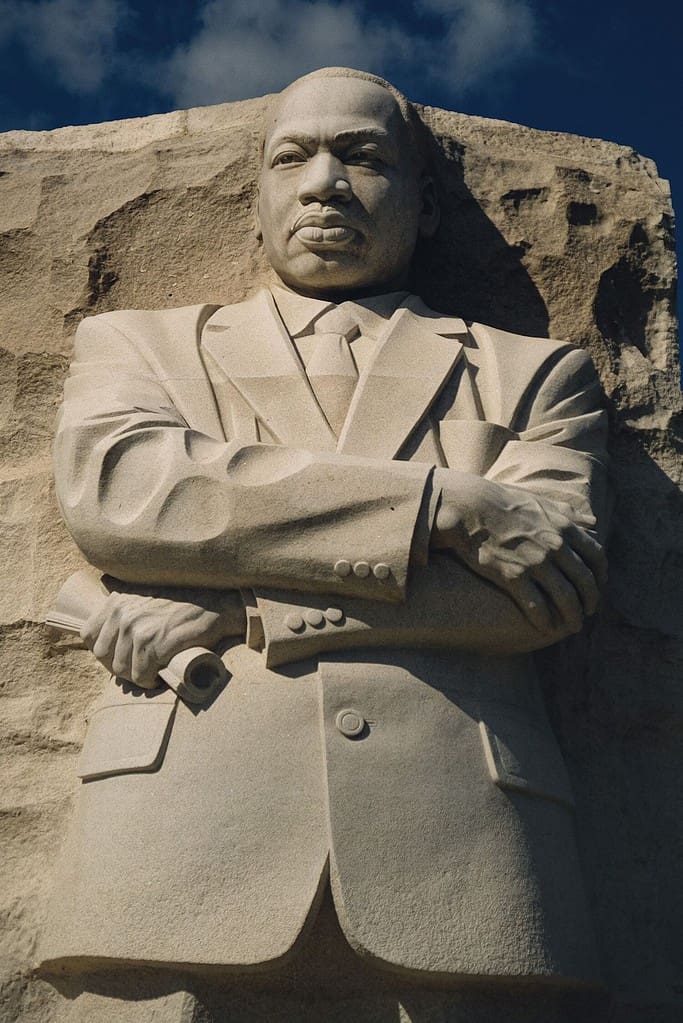
Martin Luther King, Jr. is just one of the many notable people from Alabama.
©Wirestock Creators/Shutterstock.com
Final Thoughts on the Size of Alabama
There is plenty to love about the deep south state of Alabama! Whether you visit to try the fried chicken, boiled peanuts, or buttered biscuits, want to tour iconic sites from the Civil Rights era, take a vacation on one of Alabama’s Gulf Shore sandy beaches, or hike the Appalachian Mountain ridges, Alabama has so much to offer! Despite Alabama’s size, while it is not the biggest or the smallest state in the U.S., it sure is a unique one with an interesting history and a vibrant culture.
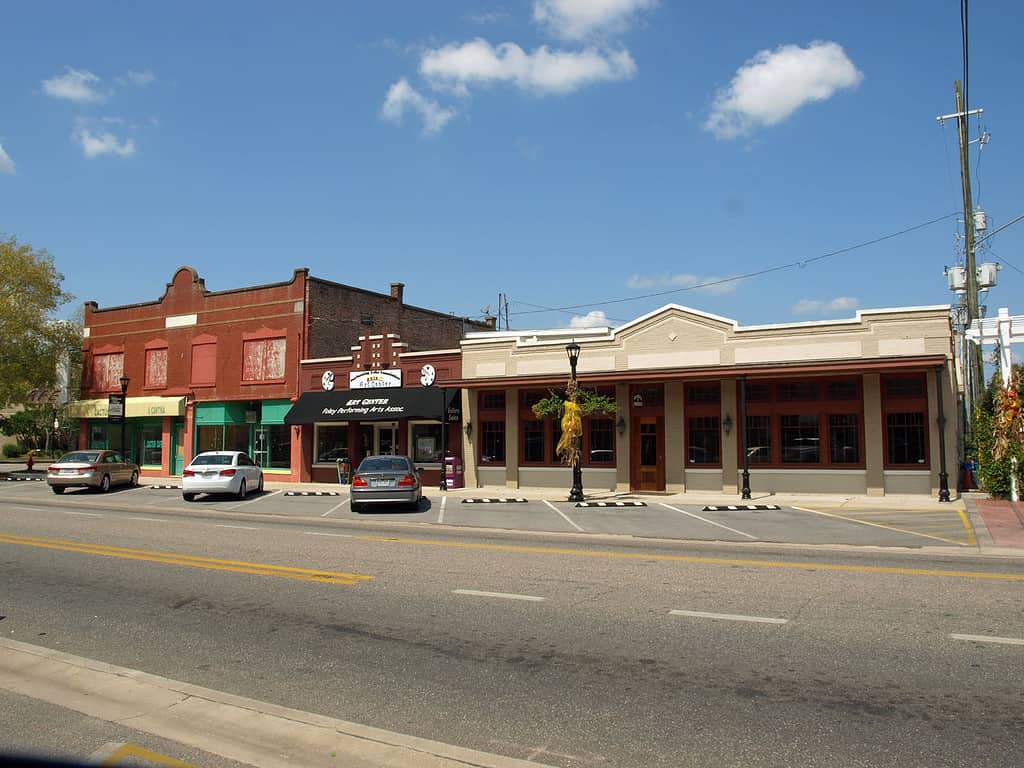
Foley, Alabama is just one of the state’s many towns full of history and culture.
©CC BY-SA 3.0 – License
The photo featured at the top of this post is © felixmizioznikov/iStock via Getty Images
Thank you for reading! Have some feedback for us? Contact the AZ Animals editorial team.






